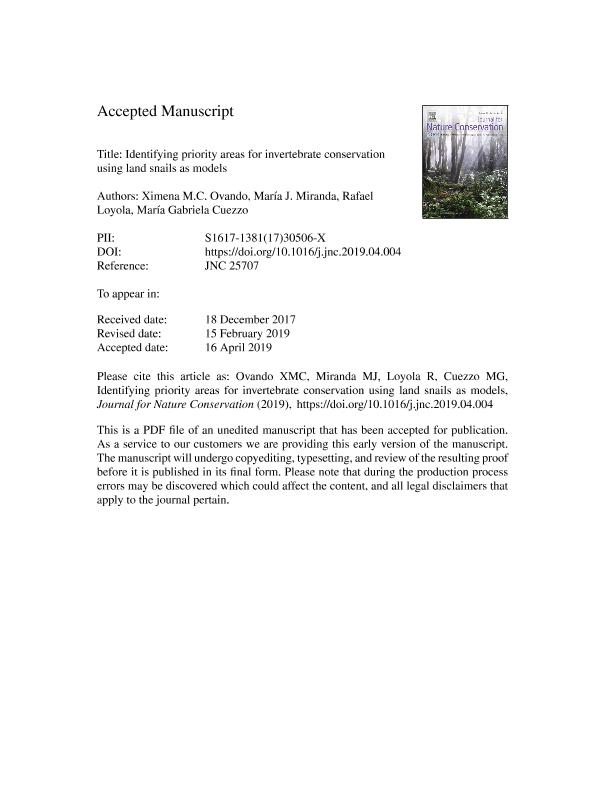Artículo
Identifying priority areas for invertebrate conservation using land snails as models
Fecha de publicación:
08/2019
Editorial:
Elsevier Gmbh
Revista:
Journal for Nature Conservation
ISSN:
1617-1381
Idioma:
Inglés
Tipo de recurso:
Artículo publicado
Clasificación temática:
Resumen
Mollusca is a megadiverse phylum with an estimated number of 70,000–76,000 described species which can inhabit a wide variety of environments. Among them, land snails are a main component of terrestrial ecosystems and they play a pivotal role in ecosystem functioning. They are suffering habitat loss, overexploitation and competition from introduced species, but are regarded as a “non-charismatic” group for conservation purposes. Orthalicoidea is a dominant faunal element in the Neotropics and in Argentina includes 104 species that inhabit a variety of environments. Their abundance, diversity, comprehensive taxonomy and widespread representation in different ecoregions makes this molluscan group an excellent model for biodiversity assessments. The database used here consisted of 985 unique geographic records of 104 species. Species distribution models were generated using the Maximum Entropy method and Zonation v 3.1 was used to evaluate the proposed conservation goals. Three analyses including species distributions, the current protected areas system (PAs) and the Human print layer were carried out. This allowed the identification of priority areas for conservation, the percentage of the species distribution under PAs and analysis of the potential impacts under current land use and in the priority areas detected above. Sixty-one species were modeled, and 59 of them were included in the priority area selection process due to their high area under curve (AUC) scores. Five high priority areas located in the different ecoregions, were identified: 1-dry Chaco, 2-humid Pampas, 3-Southern Andean Yungas, 4-Alto Paraná Atlantic Forests and 5-high Monte. A small percentage of the average distribution range of Orthalicoidean species (3%) was within the current protected areas. Highest-ranked priority areas for land snails are outside the current protected areas system. When human impact is considered, the priority areas are reduced in size and appear as small patches. However, highest priority areas for conservation continue being those detected in the above analyses. Most of the areas detected are used for economic purposes, creating conflicts of interest between the development of human activities and conservation. This study represents one of the first attempts to identify ecoregion level priority areas for a terrestrial invertebrate group. Further analyses, including new predictors and other molluscan taxa, would improve planning the conservation of poorly known invertebrate groups.
Archivos asociados
Licencia
Identificadores
Colecciones
Articulos(IBN)
Articulos de INSTITUTO DE BIODIVERSIDAD NEOTROPICAL
Articulos de INSTITUTO DE BIODIVERSIDAD NEOTROPICAL
Citación
Ovando, Ximena Maria Constanza; Miranda, Maria Jose; Loyola, Rafael; Cuezzo, Maria Gabriela; Identifying priority areas for invertebrate conservation using land snails as models; Elsevier Gmbh; Journal for Nature Conservation; 50; 8-2019; 1-38
Compartir
Altmétricas




